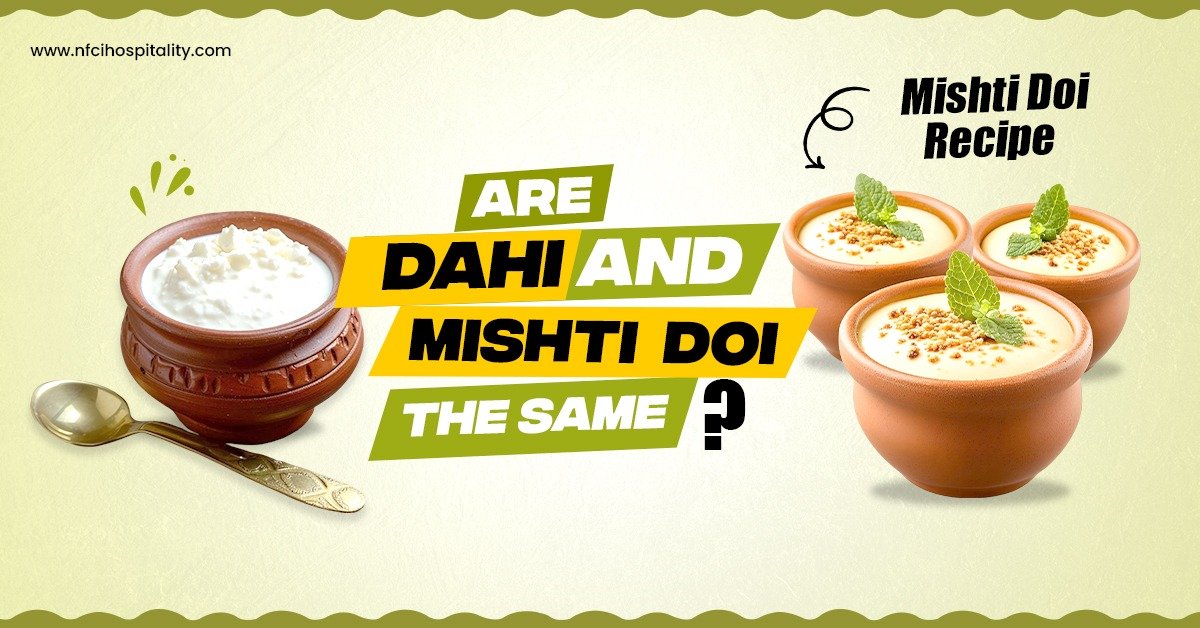
Are Dahi and Mishti Doi the same? | Mishti Doi Recipe
Do you enjoy having Dahi or Mishti Doi for breakfast? If yes, then you must have wondered — what’s the difference between Dahi and Mishti Doi? Many people think that dahi and mishti doi are similar, they believe Bengalis call Dahi “Mishti Doi,” or think it’s just sweetened Dahi.
While it’s true that Mishti Doi is sweet and both are fermented dairy products (curd or yogurt), they differ in taste, texture, and preparation We are sure that after reading this blog you will know the clear difference between dahi and mishti doi. Let’s break down the details:
What is Dahi (Curd)?
Dahi or Regular Dahi is a natural, slightly sour dairy product with varying levels of tanginess depending on the fermentation process. It is made by introducing good bacteria into fermented warm milk, which produces lactic acid and gives it a tangy flavour.

It can be creamy or thick especially if strained and it is widely used in Indian cuisine — from savoury curries and raita to cooling drinks like lassi and chaas. It is a staple in most Indian households.
What is Mishti Doi?
Mishti Doi, on the other hand, is a sweet, creamy, and mildly tangy fermented dessert. It is made by reducing milk, sweetening it with sugar, jaggery, or condensed milk, and then fermenting it overnight.

Originating from Bengal, this iconic dessert is popular across India and is traditionally served chilled in earthen pots. The texture is pudding-like, and its caramelized flavour makes it a beloved dessert, especially after meals.
How is Mishti Doi Different from Regular Dahi?
- Taste
- Dahi: Naturally sour or tangy.
- Mishti Doi: Sweet with a hint of tanginess.
- Texture
- Dahi: Dahi can be soft, creamy, or slightly watery depending on preparation.
- Mishti Doi: Mishti Doi, on the other hand is thick, creamy, and smooth — almost like a dessert pudding.
- Sweetening
- Dahi: No sweeteners added; it’s plain.
- Mishti Doi: Sweetened with sugar, jaggery, or condensed milk before fermentation.
- Preparation Process
- Dahi: Boil milk, cool it, add curd culture, and ferment at room temperature.
- Mishti Doi: Boil and reduce milk, add sweetener, and ferment overnight (often in earthen pots).
- Dahi vs Mishti Doi Origin
- Dahi: Common across all parts of India.
- Mishti Doi: Traditional dessert from Bengal, now loved all over India.
- Use in Food
- Dahi: Used in daily meals – raita, gravies, chaas, lassi.
- Mishti Doi: Served as a dessert after meals.
- Serving Style
- Dahi: Stored in steel or glass containers, eaten with food.
- Mishti Doi: Traditionally served in earthen pots to enhance flavor and texture.
- Cultural Significance
- Dahi: A daily dietary element and used in rituals.
- Mishti Doi: Associated with festivals, weddings, and celebrations in Bengali culture.
- Color
- Dahi: White to pale off-white.
- Mishti Doi: Light brown or reddish tint (especially in Nabadwip-er Lal Doi).
Fun Fact:
The slight reddish tinge you sometimes see in Mishti Doi comes from a technique variation — it’s called Nabadwip-er Lal Doi (Red Curd of Nabadwip), a local favorite in Bengal.
Mishti Doi – Traditional Bengali Sweet Yogurt
 Serves: 4
Serves: 4
Prep Time: 15 mins | Cook Time: 1 hr | Set Time: 6–8 hrs (or overnight)
Ingredients:
- Full cream milk – 1 liter
- Jaggery (nolen gur or regular jaggery) – 200–250 grams (adjust to taste)
- Curd (plain yogurt) – 2 tablespoons (for fermentation)
- Earthen pots – optional but recommended for authentic flavour & texture
Traditional Method:
- Boil & Thicken the Milk:
In a heavy-bottomed pan, boil the milk.
Simmer and stir continuously until it reduces to about 3/4th of its original volume (thick and creamy).
Scrape the sides while stirring to avoid burning.
- Melt the Jaggery:
In a separate pan, gently melt the jaggery with 2 tbsp water (do not boil).
Strain to remove impurities.
Let it cool slightly (lukewarm but not cold).
- Mix Jaggery with Milk:
Once the milk is warm (not hot), stir in the melted jaggery slowly.
Mix well. Ensure milk isn’t too hot or it may curdle.
- Add Yogurt:
When the jaggery-milk mixture is just lukewarm, add the yogurt starter.
Stir well to mix evenly.
- Set the Doi:
Pour the mixture into an earthen pot for the best results (it absorbs excess moisture and adds flavor).
Cover and keep in a warm place for 6–8 hours or overnight, undisturbed, until it sets.
- Chill & Serve:
Once set, refrigerate for a few hours before serving.
Garnish with a drizzle of melted jaggery or chopped pistachios (optional).
Traditional Serving: If we’re making a traditional dish, why not serve it in a traditional way?
Mishti Doi is traditionally set in earthenware pots, which allow gradual evaporation of moisture through their porous walls. This helps in further thickening the curd and maintaining the right temperature for fermentation. Sometimes, it’s lightly flavoured with cardamom for an aromatic touch. At times, you may notice a reddish tinge in Mishti Doi — this comes from a slight variation in the preparation technique.
In some parts of Bengal, you may notice a reddish Mishti Doi — known as Nabadwip-er Lal Doi (Red Yogurt of Nabadwip). This color results from caramelization or use of date molasses during the preparation.
Join NFCI (The National Finishing and Cooking Institute) to Master Iconic Dishes!
Dahi and Mishti Doi are two of the most common dairy-based dishes enjoyed across India. But do you really know the difference between them?

Understanding such basics is essential for anyone passionate about food.
Join a culinary course at NFCI to deepen your food knowledge and learn to cook healthy meals that can bring a positive change to your daily lifestyle.
Ready to begin? Call us now at +91-98880-11222 and embark on your culinary journey with NFCI!





